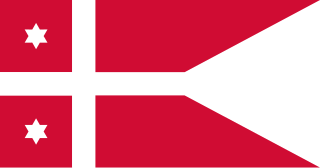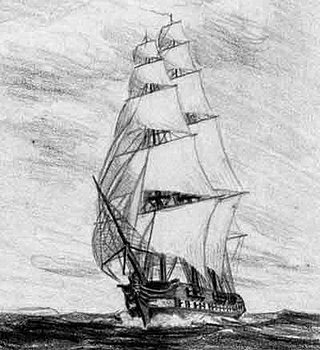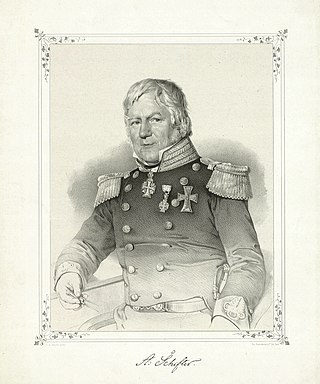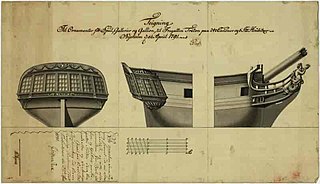Søehesten was an 18-gun barge of the Royal Dano-Norwegian Navy, commissioned in 1795. During the Battle of Copenhagen on 2 April 1801, it was commanded by Lieutenant B. U. Middelboe with a complement of 178 sailors. 12 of the ship's crew were killed in the battle, and 21 wounded. The ship struck its colours at 14.30.

HDMS Najaden was a frigate of the Royal Dano-Norwegian Navy, which she served from 1796 until the British captured her in 1807. While in Dano-Norwegian service she participated in an action at Tripoli, North Africa. She served the Royal Navy as the fifth rate HMS Nyaden from 1808 until 1812 when she was broken up. During her brief British service she participated in some small attacks in the Barents Sea during the Anglo-Russian War.
The Admiral Danish Fleet (ADMDANFLT) was the operationally supreme organisation of the Royal Danish Navy between 1 January 1991 and 30 September 2014.
The name of Steen Andersen Bille is closely associated with one extended family of Danish naval officers over several generations.

HDMS Friderichssteen or HMS Frederichsteen was a Danish Navy frigate, built in 1800, and captured by the Royal Navy in 1807 at the Battle of Copenhagen. She was taken into service as HMS Fredericksteen and served in the Mediterranean until being finally broken up in 1813.

HDMS Elephanten was a ship of the line of the Royal Dano-Norwegian Navy that served from 1703 to 1728. There were three other Danish ships-of-the line of the same name, dating from 1684, 1741 and 1773. The ship was sometimes referred to as Nye Elefant to differentiate from others of similar name. For much of her service career, which coincided with the Great Northern War, Elephanten was the flagship of the Danish fleet active in the Baltic Sea.

The Chief of the Royal Danish Navy is the professional head of the Royal Danish Navy.

HDMS Bellona was a frigate of the Royal Danish Navy, which she served from 1835 to 1862.
HDMS Friderichsværn was a Danish frigate built at Nyeholm, Copenhagen, in 1783. The British Royal Navy captured her in 1807 and took her into service as HMS Frederickscoarn. It sold her in 1814.

Henrik Gerner (1742–1787) was a Danish naval officer who specialised in shipbuilding and naval architecture. His interests as an entrepreneurial engineer led to unsinkable gun platforms, horse-driven dredging machines, and desalination equipment for Orient-bound trading ships.

Frantz Christopher Henrik Hohlenberg was a Danish naval officer who specialised in ship design and had little seagoing experience. He succeeded Ernst Wilhelm Stibolt as Master Shipbuilder (fabriksmester) at the Royal Danish Dockyards in 1796. His ships included five ships of the line and 18 frigates. Three of the ships of the line and nine of the frigates were captured at the 1807 Battle of Copenhagen and subsequently added to the Royal Navy. He resigned after a controversy in 1803.
HDMS Hvide Ørn , was a light frigate designed by Frantz Hohlenberg and built in Copenhagen. She capsized and was lost with all hands off Corsica at the end of 1799. There were three previous ships bearing this name in the Danish navy. The name was after the loss of the ship retired. An 1898 model of the ship is in the collection of the Royal Danish Naval Museum.

Andreas Schifter (1779–1852) was a Danish naval officer and shipbuilder, a capable naval administrator and admiral. He oversaw the transition of the Danish navy from sail to early steam power.
HDMS Nidelven was a brig launched at Copenhagen on 1 December 1792. She was present at both British attacks on Copenhagen, and the British Royal Navy seized her at Copenhagen on 7 September 1807 at the surrender of Copenhagen. The British took her into service as HMS Nid Elven. She served between 1808 and 1809, during which time she captured a small French privateer. She was laid up in 1809. The Navy sold her in 1814.

HDMS Triton was a Danish frigate launched in 1790 which operated in Danish/Norwegian home waters and in the Mediterranean in the protection of Danish merchant ships - not only from Barbary pirates but also from potential British privateers. The period in which it operated was fraught with political and practical difficulties which led to two battles at Copenhagen and other, lesser, actions.

HDMS Justitia was a Royal Dano-Norwegian Navy ship-of-the-line, built to a design by Henrik Gerner. Although launched in 1777, she was not fully commissioned until 1780. The British Royal Navy seized her in 1807, together with the rest of the Danish fleet after the second battle of Copenhagen. The British never commissioned Justitia. A renaming to Orford in 1809 was cancelled. She was broken up in 1817.

HDMS Justitia was a ship-of-the-line designed by Ole Judichaer built at Nyholm, Copenhagen for the Royal Danish-Norwegian Navy.

Edouard Suenson (1805-1887) was a Danish vice admiral known for his participation in the First and Second Schleswig War, and served as the main Danish commander at the Battle of Heligoland in the latter.

HDMS Slesvig (Sleswig) was a ship of the line of the Royal Danish Navy, which she served from 1725. In 1733, she was transferred to the new Danish Asiatic Company.














